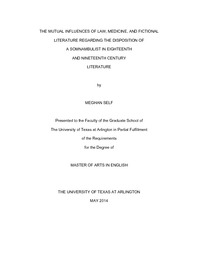
ATTENTION: The works hosted here are being migrated to a new repository that will consolidate resources, improve discoverability, and better show UTA's research impact on the global community. We will update authors as the migration progresses. Please see MavMatrix for more information.
Show simple item record
| dc.contributor.author | Self, Meghan | en_US |
| dc.date.accessioned | 2014-07-14T20:21:51Z | |
| dc.date.available | 2014-07-14T20:21:51Z | |
| dc.date.issued | 2014-07-14 | |
| dc.date.submitted | January 2014 | en_US |
| dc.identifier.other | DISS-12570 | en_US |
| dc.identifier.uri | http://hdl.handle.net/10106/24400 | |
| dc.description.abstract | Somnambulism derives from the Latin words somnus- sleep and ambulare- to walk around, meaning a person appears to conduct waking actions, but is actually asleep. Classified as a disease, somnambulism raises questions of its possible causes and cures, as well as what constitutes the difference between the conscious and unconscious mind. During the eighteenth and nineteenth centuries, medical physicians were beginning to explore somnambulism as well as other mental disorders in more depth than in previous years. It is interesting to note that during the time of medical research on these diseases, fictional Gothic writers were also beginning to incorporate some of the new medical literature into their work. Through this exploration, many questions arose regarding a somnambulism, but one of the most intriguing, and still largely unanswered questions pertains to homicidal somnambulism: if a person is unconscious during a somnambulistic episode, then is that person culpable for his or her actions that occur during the episode? Medical, legal, and fictional literatures explore these questions through several fascinating theories, diagnoses, and interpretations. In this project I argue that the discourses of law, medicine, and fictional literature in the eighteenth and nineteenth centuries were not as separate as they are today, and that many ideas circulated between the different discourses. For example, reading a novel could influence a lawyer's defense strategy, and novelists could be influenced by an awareness of new legal precedents, or new medical theories. Additionally, because of the circular nature of these institutionalized discourses, and an alteration to the traditional Gothic genre, it is possible that the Gothic novelists influenced the public's perception of somnambulism, particularly criminal somnambulism through the interconnection of the legal, medical, and literary discourses. | en_US |
| dc.description.sponsorship | Matheson, Neill | en_US |
| dc.language.iso | en | en_US |
| dc.publisher | English | en_US |
| dc.title | The Mutual Influences Of Law, Medicine, And Fictional Literature Regarding The Disposition Of A Somnambulist In Eighteenth And Nineteenth Century Literature | en_US |
| dc.type | M.A. | en_US |
| dc.contributor.committeeChair | Matheson, Neill | en_US |
| dc.degree.department | English | en_US |
| dc.degree.discipline | English | en_US |
| dc.degree.grantor | University of Texas at Arlington | en_US |
| dc.degree.level | masters | en_US |
| dc.degree.name | M.A. | en_US |
Files in this item
- Name:
- Self_uta_2502M_12570.pdf
- Size:
- 553.9Kb
- Format:
- PDF
This item appears in the following Collection(s)
Show simple item record


